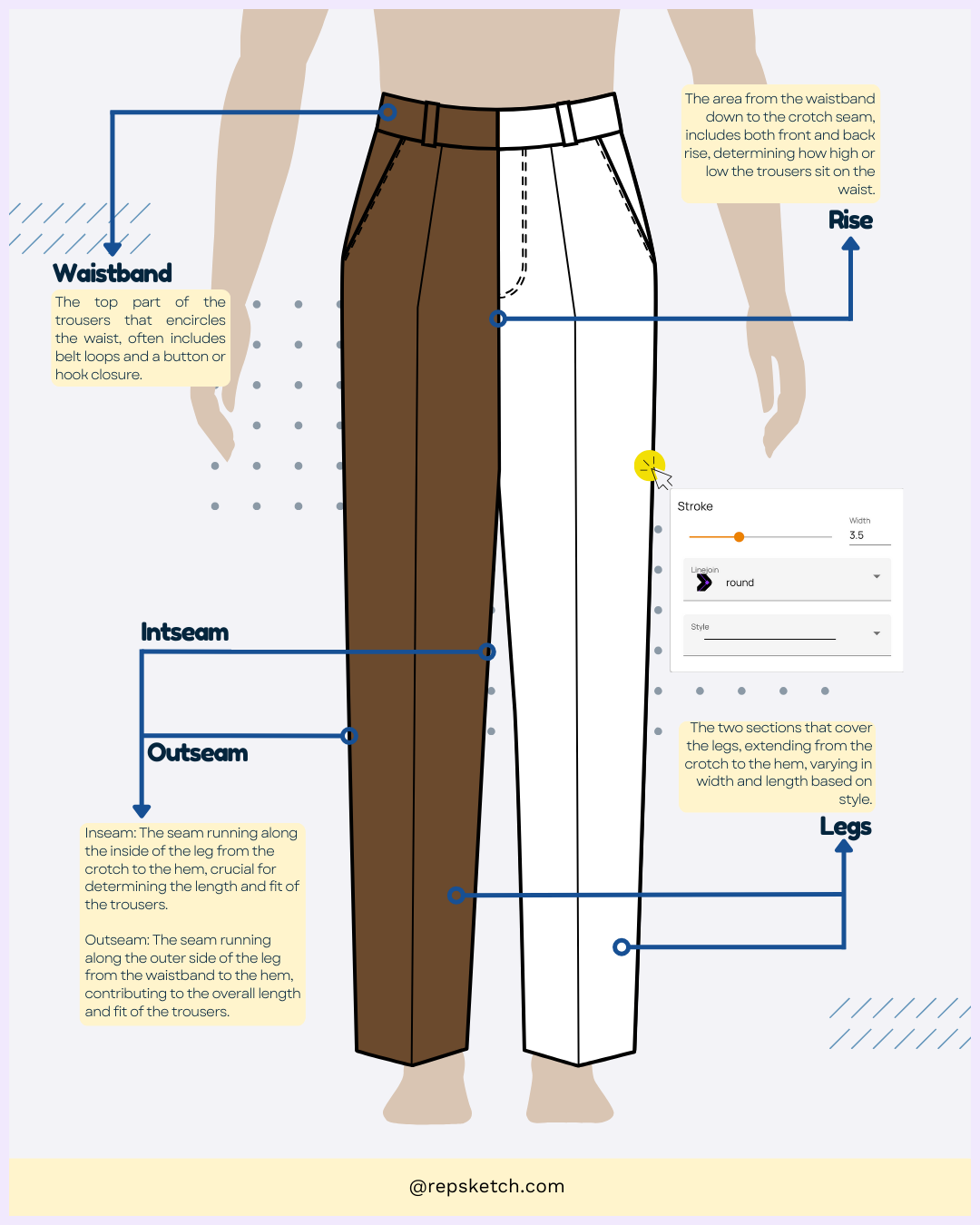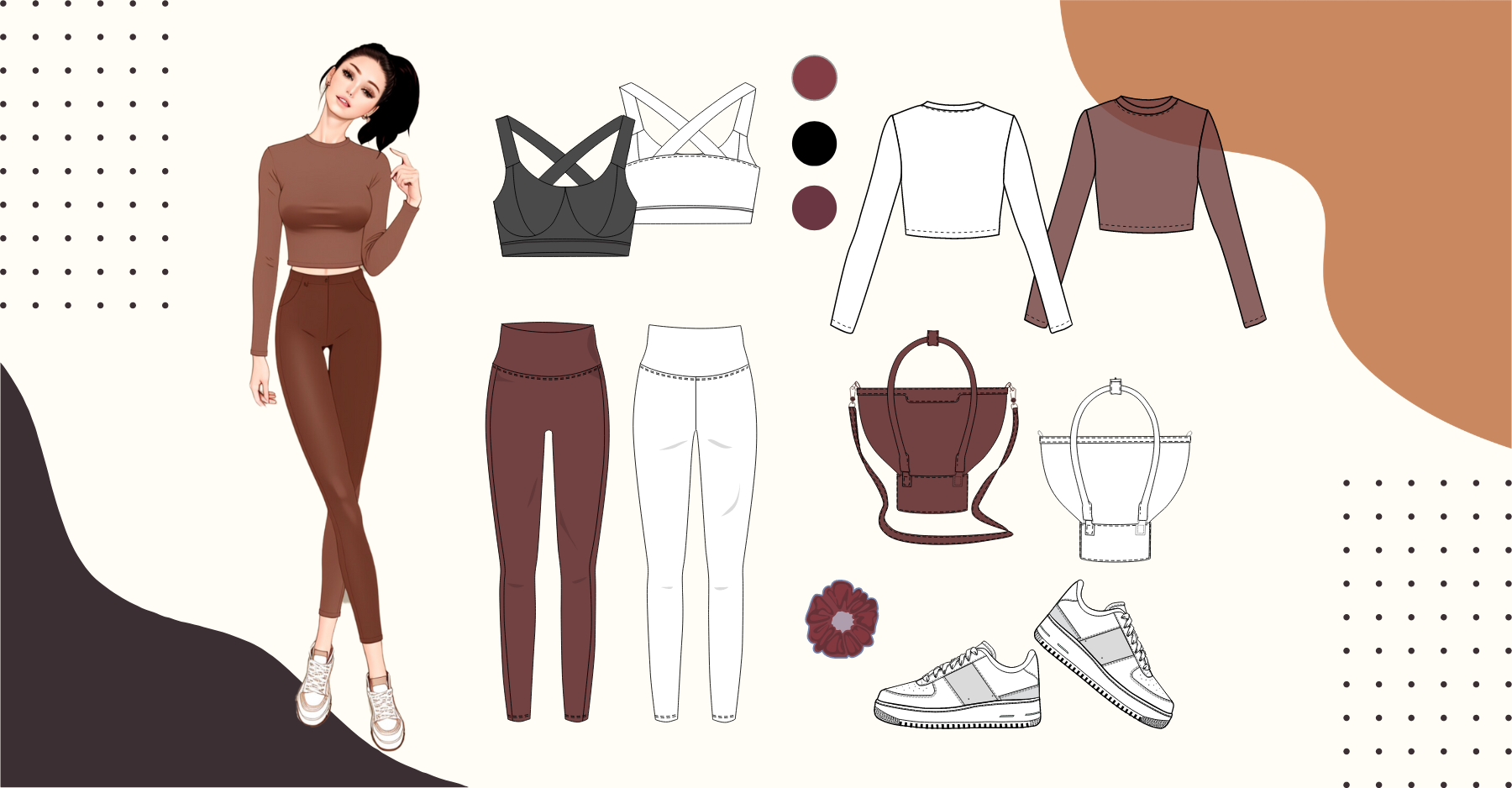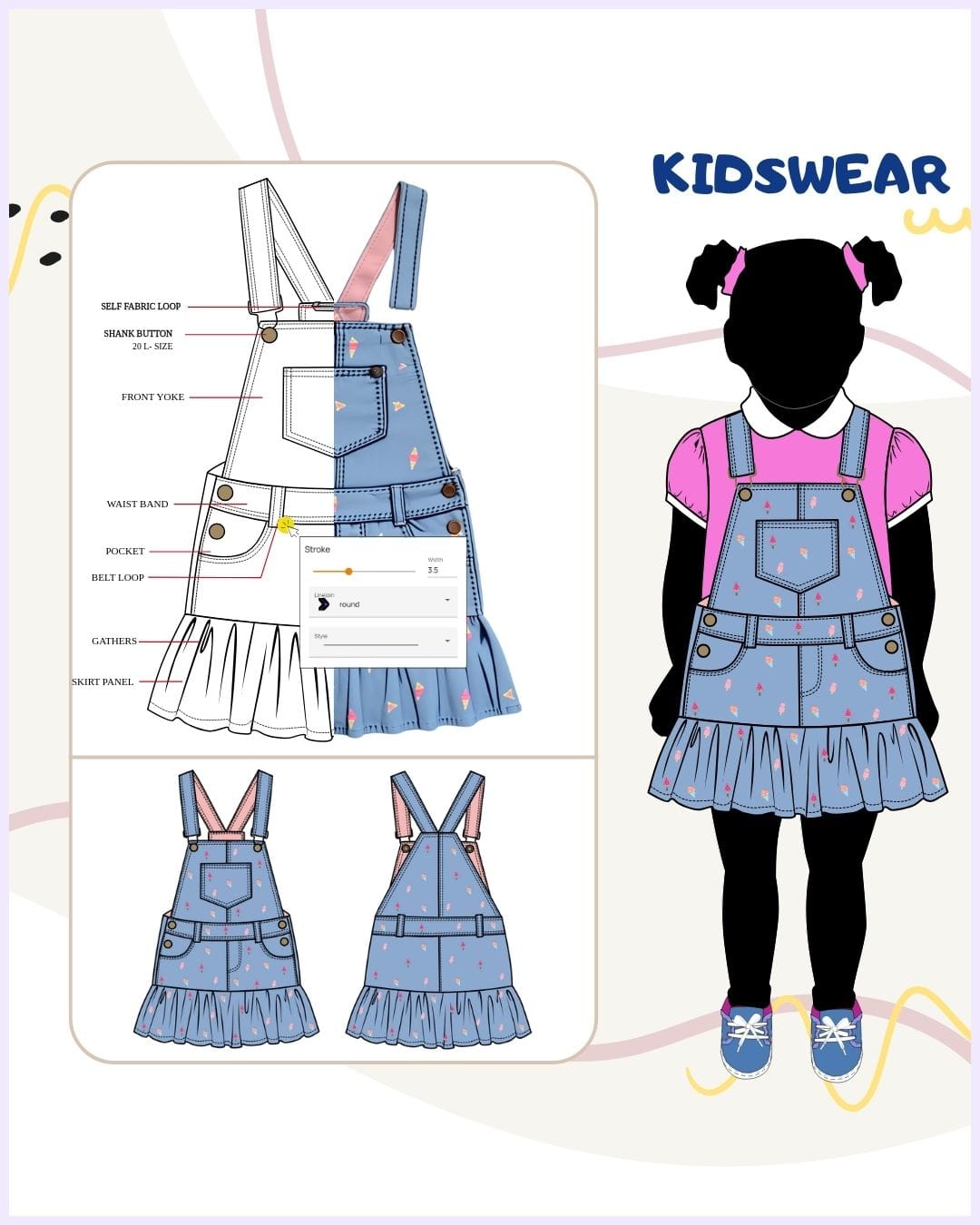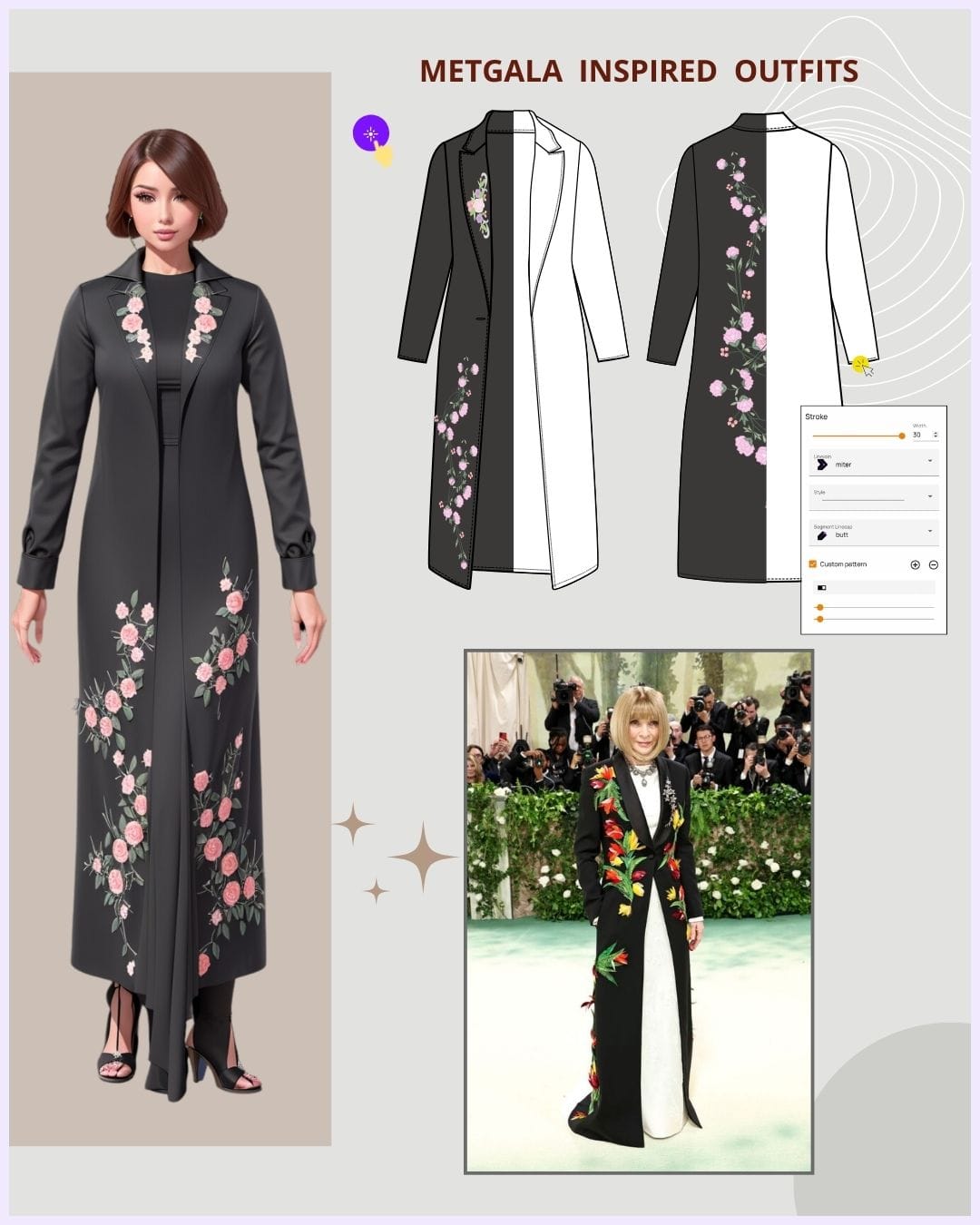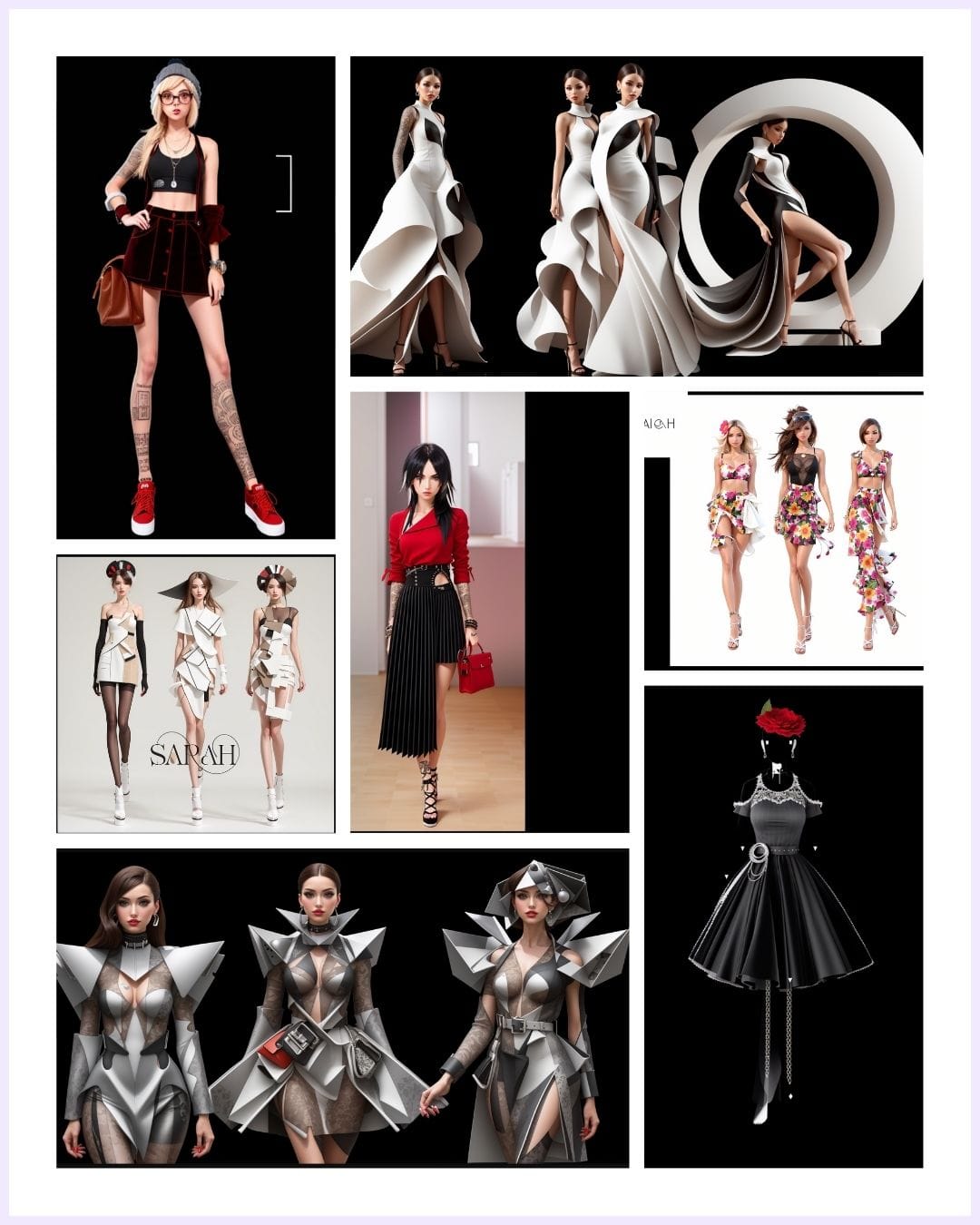Contents
Ever thought about the versatility and style of different pant types in your outfits? Pants are more than just a garment – they define your look, offering both function and fashion. Whether it's the relaxed feel of wide-leg pants or the sleek silhouette of skinny jeans, each type of pant brings its own unique vibe. For instance, joggers add a sporty touch, while tailored trousers are perfect for a professional setting.
When designing pants, technical drawings or illustrations are essential to transforming your creative ideas into visual representations that guide the production process. Digital vector drawings offer precision and scalability, making them ideal for fashion design.
In this blog post, we've covered everything you need to learn about drawing technical sketches and mock-ups of your pants designs to ensure you produce high-quality garments with your manufacturer. Let's dive into it!
Understanding the Basics of Pants
Understanding the key elements like anatomy and measurement points is essential for creating well-fitting and stylish pants. This section delves into these foundational details that every designer should know. Mastering these basics ensures your pants not only look great but also fit comfortably, setting the stage for creative fashion designs.
Anatomy of a Pant

The anatomy of pants includes the various parts and pieces that make up the garment's overall structure and design. Knowing these parts is important for designers, manufacturers, and consumers. Here are the main components of a typical pair of pants:
Waistband: The top edge of the pants, typically reinforced with a band of fabric that encircles the waist. Provides structure and support, often includes belt loops, buttons, or elastic for adjustment.
Front Rise: The distance from the crotch seam to the top of the waistband at the front. Determines how high the pants sit on the front, affecting comfort and style, with variations from low-rise to high-rise.
Back Rise: The distance from the crotch seam to the top of the waistband at the back. Ensures adequate coverage and fit around the buttocks, contributing to the overall balance and comfort of the pants.
Fly: The front closure of the pants, typically featuring a zipper or buttons. Allows easy opening and closing of the pants, with some styles including an additional button or hook for secure fastening.
Inseam: The seam running along the inside of the leg from the crotch to the hem. A key measurement for determining the length of the pants, influencing fit and style.
Outseam: The seam running from the waistband to the hem along the outer side of the leg. Another crucial length measurement, often used in tailoring to achieve the desired pant length.
Crotch: The area where the front and back rises meet, forming a junction at the base of the fly and the top of the inseam. Vital for fit and comfort, affecting how the pants move and sit on the body.
Seat: The area covering the buttocks, shaped by the back rise and the width of the pant legs. Ensures a snug fit around the hips and buttocks, impacting the overall silhouette of the pants.
Pockets: Functional and decorative elements typically found on the front, sides, and back of the pants. Provide storage and style accents, with variations such as slash pockets, welt pockets, and cargo pockets.
Hem: The bottom edge of the pant legs, finished to prevent fraying and achieve the desired length. Affects the overall appearance, with styles ranging from cuffed to raw or tapered hems.
Pleats: Folds of fabric sewn into the waistband, usually at the front. Add volume and ease of movement, often seen in dress pants for a more formal look.
Darts: Tapered seams that shape the fabric to fit the contours of the body, usually found in the back. Enhance the fit by taking in excess fabric, creating a tailored and fitted appearance.
Yoke: A panel of fabric at the back of the pants, just below the waistband, commonly found in jeans. Adds shape and support, contributing to a better fit around the hips and waist.
These components work together to create a pair of pants that fits well, looks good, and provides comfort and functionality. Understanding each part helps in designing, altering, and selecting pants that meet specific needs and preferences.
Points of Measurement

When designing or fitting pants, understanding the key points of measurement is crucial for ensuring a perfect fit. These measurements help in creating a garment that is not only comfortable but also flattering. Here are the essential points of measurement for pants:
A - Waist: Measure around the narrowest part of the waist, typically just above the belly button. This measurement ensures that the waistband fits snugly without being too tight.
B - Hip: Measure around the fullest part of the hips, usually about 7-9 inches below the waistline. This is crucial for ensuring the pants fit well around the hips and buttocks.
C - Front Rise: Measure from the top of the waistband at the front to the crotch seam. This determines how high the pants sit on the front of the body.
D - Back Rise: Measure from the top of the waistband at the back to the crotch seam. This is typically longer than the front rise to accommodate the curvature of the back.
E - Inseam: Measure from the crotch seam to the bottom of the pant leg. This determines the length of the pants from the crotch to the ankle.
F - Outseam: Measure from the top of the waistband to the bottom of the pant leg along the side seam. This helps in determining the overall length of the pants.
G - Thigh: Measure around the fullest part of the thigh, just below the crotch. This ensures the pants are comfortable around the upper leg.
H - Knee: Measure around the knee area, typically midway down the pant leg. This is important for pants that are fitted or tapered at the knee.
I - Leg Opening: Measure around the bottom of the pant leg. This measurement is crucial for different styles of pants, such as skinny, straight, or flared.
J - Crotch Depth: Measure from the center of the waistband at the front to the center of the waistband at the back, passing through the crotch. This helps in determining the overall rise and fit of the pants.
Understanding these key points of measurement ensures that your pants fit well and are comfortable to wear. Whether you're designing new pants or altering existing ones, these measurements are essential for achieving a perfect fit.
Types of Pants
Pants are a wardrobe staple, but the variety can be overwhelming. Understanding the different types of pants can help you choose the right style for any occasion. In this section, we'll explore pants based on fit, length, waist placement (rise), and special features. From skinny to wide-leg, full-length to shorts, high-waisted to cargo pants, we'll cover the diverse options available to elevate your fashion game. Whether you're looking for something casual or formal, practical or stylish, there's a perfect pair of pants for everyone.
Types of Pants based on Fit:

Skinny Pants
Skinny Pants are tight-fitting pants that hug the legs from the waist to the ankles. They emerged in the late 20th century and gained popularity in the 2000s. Known for their extremely close fit, they often include a bit of stretch for comfort, making them versatile for both casual and semi-formal wear.

Slim Pants
Slim Pants feature a narrow cut that fits close to the body but is not as tight as skinny pants. These pants became popular in the late 20th and early 21st centuries. They taper from the hips to the ankles, offering a modern and sleek look ideal for a polished appearance.

Straight-Leg Pants
Straight-Leg Pants have a consistent width from the hips to the ankles, offering a classic style that has remained popular for decades. With a balanced fit that is neither tight nor loose, they are timeless and versatile, suitable for any occasion.

Bootcut Pants
Bootcut Pants are fitted through the thighs and flare out slightly from the knees to the hem. Originally designed to fit over boots, they became popular in the 1970s and saw a resurgence in the 1990s. With a subtle flare, they are practical and stylish, often made from denim.

Flared Pants
Flared Pants are characterized by a significant flare from the knees downward. Iconic in the 1960s and 1970s, they are associated with the hippie movement. Fitted through the waist and thighs with a dramatic flare, they are bold and eye-catching, perfect for making a fashion statement.

Wide-Leg Pants
Wide-Leg Pants are wide through the entire leg. Popular in the 1920s and 1930s, these pants have seen revivals in various decades. They offer a loose and flowy fit, providing comfort and freedom of movement. Elegant and sophisticated, they are often made from lightweight fabrics.

Relaxed Fit Pants
Relaxed Fit Pants provide a looser fit throughout, offering more room for comfort. They gained popularity in the 1980s and 1990s. Loose from the waist to the hem, they are ideal for relaxed settings and casual wear.

Baggy Pants
Baggy Pants are very loose-fitting with extra room in the seat and thighs. Associated with hip-hop culture in the 1990s, they offer an extremely loose and oversized fit, making them a staple in casual and streetwear fashion.
Types of Pants based on Length:

Full-Length Pants
Full-Length Pants extend down to the ankles and are the most common type of pants length, worn for centuries. Their fit can vary from skinny to wide-leg, making them versatile and suitable for all occasions.

Ankle Pants
Ankle Pants end at or just above the ankles, becoming fashionable in the 1950s. They can be slim or straight, offering a chic and modern look that is perfect for showcasing shoes.

Capri Pants
Capri Pants end mid-calf and were popularized in the 1950s, named after the island of Capri. Typically slim or fitted, they are casual and summery, ideal for warm weather.

Cropped Pants
Cropped Pants end between the knees and ankles and gained popularity in the 20th century. With fits ranging from slim to wide-leg, they are trendy and versatile, great for a modern look.

Knee-Length Pants
Knee-Length Pants end just below the knees and have been popular in various forms, like Bermuda shorts, throughout the 20th century. They can be fitted or loose, offering a casual and practical option for warm weather.

Shorts
Shorts end above the knee and have been worn for centuries in various cultures, becoming modern staples in the early 20th century. Their fit varies from fitted to baggy, providing a comfortable and casual option for hot weather.
Types of Pants based on Rise:

High-Rise Pants
High-Rise Pants or high-waisted pants feature a waistband that sits above the natural waistline. Popular in the 1940s and 1950s, and again in the 2010s, they accentuate the waist and elongate the legs, offering a vintage and modern style suitable for various outfits.

Mid-Rise Pants
Mid-Rise Pants feature a waistband that sits at the natural waistline and are the most common rise for pants, popular in various decades. They offer a balanced and comfortable fit, versatile and flattering for most body types.

Low-Rise Pants
Low-Rise Pants have a waistband that sits below the natural waistline, becoming a major trend in the late 1990s and early 2000s. Often tight around the hips and thighs, they provide a casual and trendy look, often seen in denim.
Types of Pants based on Special Features:

Cargo Pants
Cargo Pants have multiple large pockets, typically on the sides of the legs, originally designed for military use in the 1930s. They can be relaxed or fitted, offering a practical and utilitarian style popular in streetwear.

Jogger Pants
Jogger Pants are athletic-style pants with an elastic waistband and cuffs, evolving from traditional sweatpants in the 21st century. Typically loose around the hips and thighs and tapering at the ankles, they offer a casual and sporty style ideal for athleisure wear.

Palazzo Pants
Palazzo Pants are wide-leg pants that flare out from the waist, popular in the 1960s and 1970s. With a loose and flowy fit, they are elegant and comfortable, perfect for warm weather.

Culottes
Culottes resemble a skirt due to their wide legs and originated in the Victorian era, with modern revivals in the 20th century. Wide and cropped, they offer a feminine and chic style suitable for both casual and formal occasions.

Chinos
Chinos are lightweight cotton pants, typically in khaki or neutral colors, originating as military wear in the 19th century. With a slim to straight fit, they offer a versatile and preppy style suitable for casual and semi-formal settings.

Dress Pants (Trousers)
Dress Pants (Trousers) are tailored pants suitable for formal or professional wear, a staple in business attire for centuries. Typically straight or slightly tapered, they offer a classic and sophisticated style, often made from wool or synthetic blends.

Jeans
Jeans are durable pants made from denim fabric, originating as workwear in the 19th century and becoming a fashion staple in the 20th century. With various fits, including skinny, straight, and relaxed, they are versatile and timeless, suitable for all occasions.

Leggings
Leggings are tight-fitting pants made from stretchy fabric, gaining popularity in the 1980s and 2000s as both workout and casual wear. Extremely close-fitting, they offer a comfortable and versatile option often worn for athletic activities.

Overalls
Overalls are one-piece pants with an attached bib and shoulder straps, originally workwear and popularized in casual fashion in the 20th century. Loose and functional, they offer a practical and trendy style often made from denim.

Pleated Pants
Pleated Pants have pleats at the waistband for added fullness, popular in the early to mid-20th century. They can be relaxed or tapered, offering a classic and elegant style often seen in formal wear.

Bell Bottom Pants
Bell Bottom Pants flare out significantly from the knee down, iconic in the 1960s and 1970s. Fitted through the waist and thighs with a dramatic flare, they offer a bold and retro style perfect for making a fashion statement.

Parachute Pants
Parachute Pants are extremely baggy pants with a lot of extra fabric, often made from lightweight materials, popular in the 1980s and associated with breakdancing and hip-hop culture. Very loose and comfortable, they offer a casual and functional style known for their distinctive look.

Harem Pants
Harem Pants are loose, flowing pants that gather at the waist and ankles, creating a draped effect. Originating from Middle Eastern and South Asian cultures, they provide comfort and freedom of movement. Modern harem pants feature a dropped crotch and wide legs, ideal for casual and bohemian outfits.

Peg Pants
Peg Pants are tapered pants that are snug at the waist and narrow towards the ankles. Popular in the mid-20th century, they feature a high waistline and a cropped length, creating a flattering silhouette. Suitable for casual and formal settings, they are often paired with tailored tops.
How to Draw a Pant Sketch
Drawing a pant sketch using Repsketch is both effortless and enjoyable! With Repsketch, you gain access to an extensive collection of vector sketches crafted by professional designers, along with a wide array of design elements for quick and inspiring customization. Whether you opt for pre-made sketches or intricate details, everything is editable as vectors. Moreover, Repsketch provides a user-friendly online vector editor to streamline your customization process.
Here's our detailed guide on creating a pant sketch using the Repsketch App.

And here are a few other related tutorials -


Convert Pant Sketches to 3D Mockups

Repsketch offers a cutting-edge tool that uses AI to transform your ideas into photorealistic masterpieces instantly. With advanced technology and three different modes, you can easily convert your pants flat sketches into lifelike visuals. The creative possibilities are limitless. Experience the magic of turning flat 2D images into high-quality, lifelike 3D visuals with ease and bring your pants sketches to life with Repsketch!

